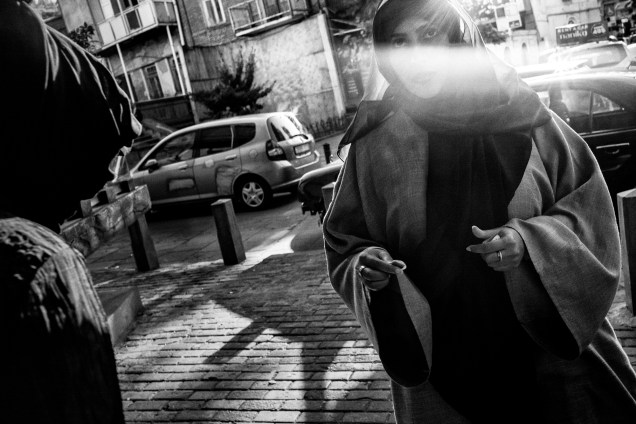
The journey through Georgia (Gruzja in Polish) in 2016 was a first for the Polish photographer. With eyes wide open and his camera always on hand, he covered a lot of ground on foot or moved around in taxis and small buses (marshrutka). His route took him from Tiflis in the east, via Batumi and Svaneti in the west, as far as the Goderdzi Pass in the south – followed by a couple of days across the border in Turkey. He spoke with us about his way of working and about the experiences he had on the trip.
How did this project come about? What made you pursue everyday life in Georgia? Have you travelled in Georgia before?
I don’t have any connection to Georgia and it was my first visit there. Sometimes in my work I like to be surprised. I had read some books about Georgia’s recent history and was curious about it. As a citizen of a country which was under USSR influence, I’m also curious about countries that gained independence and were formed after the fall of the USSR.
Please tell us something about the cities, landscapes and the locals. What did you notice about the country and its people?
Georgia is a very mountainous country – everywhere around you there are mountains, higher and lower ones. It’s also a country on the edge for many reasons. It is heavily influenced and was touched by Russia and the USSR before. It’s situated between Europe and Asia. You can find a near-tropical climate in the Batumi region or a more severe one in the Caucasus Mountain in the north. It’s also a country that is very popular with tourism nowadays – I do prefer less crowded places, in fact.
What special encounters or anecdotes were there while you were taking photos there?
One of them is that there were many Asian tourists; I mean buses full of them. In Europe we’re used to Japanese tourists, but there they were all Russian – it was strange, but it also shows how stereotypes work. Another thing is that it’s not rare to be offered alcohol on the street, waiting for buses, near a shop or in many other situations. So you have to be strong-headed, to survive (laughs).
What do you have in focus when taking pictures?
I’m especially interested in daily life, in the life around us. I would like to convey openness towards the unknown to others, to the beauty of simple things, to the beauty of small gestures and emotions between people. Daily life is universal for everyone – it’s very simple, but it’s also very important. I believe that photography has the possibility of sharing knowledge of the things that are around us, or not far from us. It facilitates the exchange of ideas and offers a small opportunity to fight against stereotypes.
What made you decide on black and white for this series?
As in my previous projects, I’m mainly interested in shapes, composition, gestures and people. Sometimes colours can have too much influence on those aspects – which is why I also preferred black and white in this case.
Do you enhance your photography (post-production) or do you use available light only, and if so, why? Do you use flash at all? If yes, when do you use it?
I mainly use available light, and I highly appreciate the capacities of Leica rangefinders in this field. I shoot RAW files, so all of my work goes through the post-production process. I shoot in colour and then edit the pictures using digital versions of analogue darkroom tools.
In general, how do you find your topics and narratives?
I like human beings and I try to incorporate them into my work. This is because I choose to take candid photos, without intervening in the scenes I see.
Do you have any photographic role models? Who has had an influence on developing your point of view?
Of course, there are many. I highly recommend going through photography books – I think it’s the best way to look for inspiration. Magazines such as LFI, photo festivals and exhibitions also have great value in this respect.
Which Leica camera system did you use to realize this project?
The Leica M has been my main camera from some time. I started with the M9, then the M240, and now I’m using an M10P. As a backup I use a Ricoh GR3. This project was shot pretty much entirely with the M240 and Summicron-M 35 f/2 Asph, and some shots with the GR. I rarely use other focal lengths than 35mm – it suits my way of seeing the best. I feel very comfortable with the Summicron-M. The size, the weight and, last but not least, the quality of the image are perfectly matched in this lens and in this combo.
What current or future projects are you working on? Where are you headed to next?
My next project is about Spanish people during the El Rocio celebrations in Andalusia. I exhibited a fraction of this project during the X FotoArtFestival in Bielsko-Biala (Poland) last month. My main interest is in the Mediterranean, and I think I’ll explore some more things about this part of the world. I do prefer to work on something for a longer time and I have many projects on the go – I’ll see where they lead me.
Born in Poznan, Poland in 1972, Tytus Grodzicki graduated with a Masters in Economics in 1995, from the Poznan University of Economics. His work has appeared in LFI 04/2020, DOC! Photo Magazine and Magazyn Pokochaj Fotografie, among others. He is a member of the Polish Association of Art Photographers, Wielkopolska region. Grodzicki lives and works in Poznan. His photo book Deglet Nour appeared in 2018. Find out more about his photography on his website and Instagram page.
Leica M
The Leica. Yesterday. Today. Tomorrow.












